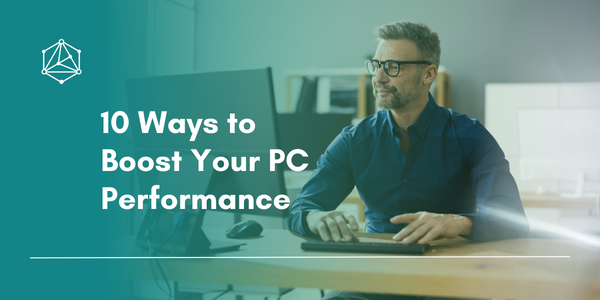With our collective decades of IT experience, we’ve learned more than a few tricks to keep our clients’ computers running smoothly and performing optimally. The good news is that some of those are simple enough for nonprofits to do on their own! Here are our certified IT technicians’ top 10 tips that you can use to improve your organization’s computer speed and overall performance – today!
1. Clean Up & Delete Old Files
Let’s face it, the ability to store so much on our devices often makes many of us act like packrats. While those gorgeous sunset views from that beach trip 10 years ago might not seem to be doing any harm, they are slowly making your device the digital equivalent of an episode of Hoarders – meaning that they are cluttering pathways where your more critical data should be navigating freely. If you don’t want those old files and photos, hit delete. If they have sentimental value, simply move them (or let us help you move them) to a cloud storage platform such as Google Drive or One Note.
2. Oust Old Programs
In a similar vein, if your device is older, there are probably countless programs that you are not using – and might not have even realized are still there. To reclaim space on your hard drive, navigate to your “Programs and Features” menu on a PC or “Applications” on a Mac to see a full list of what’s on your computer. Uninstall old programs that you don’t use regularly.
3. Clear Your Crumbs
If your computer seems uncharacteristically slow when it’s online, you might have a browser issue as opposed to a computer issue. Unless you tell it not to, most browsers automatically save your browsing history and collect cookies from all the sites you visit. While each of these cookies is figuratively the file size of a crumb, they can add up quickly and eventually slow down your browsing. Clear them out regularly and you’ll likely notice a boost in your PC performance and speed.
4. Get a High-Tech Tool
While you can clean out quite a few things manually, there are temporary, cached, and hidden files that might be more difficult to access on your own. That’s where a free tool such as CCleaner or Malwarebytes can step in. These tools allow you to eliminate files you no longer need and to keep others organized and optimized.
5. Check its Health
Speaking of tools, anti-virus software is critical to ensure that none of those hidden files is a virus or ransomware file. Your IT team and/or your MSP should be keeping anti-virus protection up to date, but help them out by following some common sense digital security practices when you are online to avoid getting a virus in the first place.
6. Save Startup Space
Did you know that available RAM (your computer’s system memory) can impact how quickly your computer starts up? If you find yourself waiting on slow starts, look at the programs that open automatically when you turn on your computer. Spotify and Skype are notorious for guzzling RAM. Visit your default settings and toggle them so they don’t automatically start, and you’ll see a change in startup speed.
7. Upgrade Your RAM
If your computer still needs to be faster after the steps above, one of the easiest ways to boost your speed is to upgrade your RAM. You don’t have to do much – adding an extra 2 to 4 gigs of RAM space often will make a noticeable difference. While you probably don’t want employees cracking into their computers, your in-house IT team can handle this very simple upgrade.
8. Invest in Solid-State Drives
Another relatively simple fix for your IT department is installing a solid-state drive. Think of a traditional HDD storage drive like an old-school record player. It has multiple platters (disks) that spin around a central axis and a mechanical arm that enables it to write and read data. An SSD doesn’t have any moving parts. It stores data on microchips vs. platters, making access virtually instantaneous and less subject to physical wear and tear. Switching to an SSD will greatly enhance your computer’s performance both at start-up and during routine tasks.
9. Play it Cool
Have you ever had your cell phone outside with you on a blazing hot summer day? If so, you’ve probably noticed that when electronic devices get too hot, they start to slow down. This is particularly true of laptops. Whether you are working outside in the heat, in a warm office, or have the computer on a soft surface, make sure it is a well-ventilated area and doesn’t overheat.
10. Shut Down to Start Up
You’ve probably never imagined that IT professionals also would rely on that old trick of turning off a device and then turning it back on again. But, yes, sometimes we do. When things are running that shouldn’t be, sometimes lag can be helped simply by turning your computer off, unplugging it, and then reconnecting and turning it back on again, which forces it to quite the offending program.
These tips are primarily designed to amp up your PC performance and improve the speed of your computer. If you have an Apple computer, you might want to visit this article on improving the speed of your Mac.
If the PCs or laptops in your organization are slowing down and you’re not sure how to correct the issue, reach out to us! Our technicians are on call and ready to help your organization with any computer issue big or small. As an integrated IT solutions partner, we’re here to help nonprofits like yours optimize the systems they have and guide them toward solutions that work.

